Transparency Can Help Developing Countries Implement the Paris Agreement


The theme of the international climate summit (COP22) this November in Morocco will center around “action and implementation,” says Dr. Hakima El Haite, Morocco's Minister-in-charge of the Environment. But how will countries rally to meet their climate goals coming out of Paris?
Transparency is vital for developing countries to enact policy that makes good on their commitments, or “nationally determined contributions,” to the Paris Climate Agreement. It is so important that governments and civil-society groups came together to launch a program called the Initiative for Climate Action Transparency (ICAT).
ICAT is a “a neutral, multi-donor trust fund designed to support developing countries in improving their capacity to measure, access, and report their climate actions, policies and their greenhouse gas emissions," Michael Jacobs, senior advisor for the Children’s Investment Fund Foundation, said at the climate talks in Bonn, Germany, on Wednesday.
There are four initial donors to ICAT: the German and Italian governments through their Ministries of Environment, the Children’s Investment Fund Foundation, and the ClimateWorks Foundation. It is held and managed by the U.N. Office for Project Services in Copenhagen, a the United Nations body that manages many international initiatives. The implementation of ICAT is being carried out by a group of organizations that includes World Resources Institute. Or, as Jacobs put it, “A variety of stakeholders are involved.”
An advisory committee for ICAT is made up of “some of the world’s leading experts from a variety of countries from around the world on measurement reporting, verification and assessment issues,” Jacobs explained. The advisory committee will be “very important in guiding the Initiative.”
“The aim of ICAT is to bring greater quality, transparency, trust and ambition to climate policies, and to facilitate more effective policy design and decision making,” Jacobs said in Bonn. “The initiative will provide tools for policy makers and other stakeholders to collect more robust and consistent data on emissions and adaptation efforts, and to help build institutional capacity in developing countries.”
Jacobs laid out three expected principal outputs of ICAT:
- A set of methodologies on how countries can better measure, assess and report on climate actions and policies. They were referred to as “global common goods” and will be made available internationally to help every nation provide more consistent data.
- Capacity building in the use of these tools will begin in 20 countries to help those countries improve their methodologies, reporting and verification systems.
- A platform for learning in which practitioners from various countries will be brought together to exchange experiences and lessons. ICAT seeks to be a clearinghouse for knowledge on climate action.
What ICAT has done so far is conduct a survey of over 350 stakeholders working in climate initiatives around the world, and it's starting to get feedback on how the needs and issues are “seen from the ground,” Jacobs said. Backers of the initiative have talked to 30 countries, which are among the candidates for the first 20 pilot countries, and have approved 17 of those. They are still talking to the others to decide which ones will be the other three countries.
Why Germany and Italy are participating in ICAT
“Transparency has always been the backbone of what we are doing here, both from an international and domestic perspective,” Nicole Wilke, chief climate negotiator for Germany and part of the German Ministry for the Environment, said on Wednesday. On the domestic side, “If you know what is going to happen in your country, then you will know how to design your policies,” Wilke declared. “You can only change things if you know what is happening."
That is what Germany learned from its own experiences, and its government decided to bring that experience “into the international sphere.” Germany will provide about $7.3 million for “combining the methodology work of transparency issues in the field of mitigation and sustainability through the actual in-country work,” Wilke said.
Italy is participating in ICAT “because we wish to be part of this common ground, this common capacity to fulfill the provision of the convention,” said Francesco La Camera, director general for sustainable development, energy and climate at the Italian Ministry of the Environment, Land and Sea.
La Camera mentioned the five-year review mechanism, which is part of the Paris Agreement and is the process for countries to strengthen their national climate action plans every five years. It gives the U.N. the capacity to “try and control the process somehow.” The five-year review mechanism consists of “target goals and you have to monitor, review and evaluate (MRV), so it’s the transparency process in itself,” he said.
In other words, Germany and Italy believe so strongly in the need for transparency within national climate plans that the two countries are ponying up money and time to create an initiative to facilitate it.
Image credit: Flickr/Kate Ausburn
Volkswagen Invests $300M in Ridesharing Service Gett
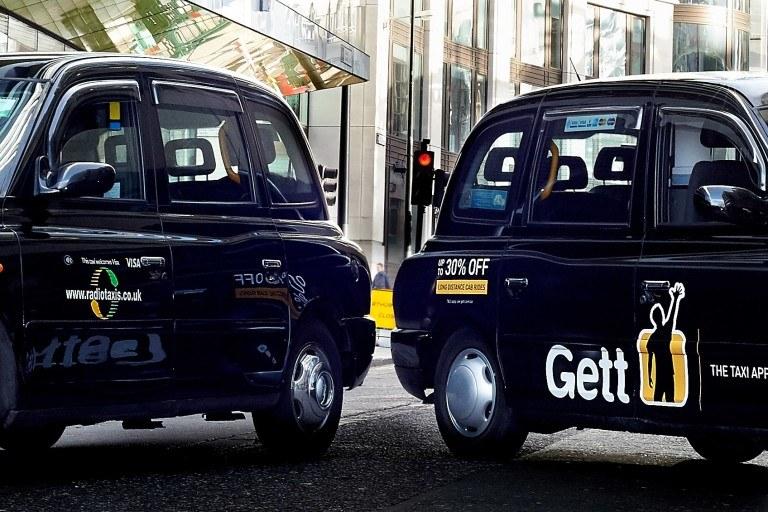

Volkswagen is struggling, largely because of the fallout over last year’s emissions scandal, the results of which included numerous lawsuits and a massive hit to the company’s finances. But the German automaker’s self-inflicted woes are not the only problems it must confront in the long term. The evolution of driving habits worldwide, especially due to ridesharing, means that all automobile manufacturers have to tweak their business models in order to survive into the 21st century.
To that end, on Tuesday Volkswagen announced it will invest $300 million in the ridesharing service Gett, with the long-term goal of developing new revenue streams in Europe.
Volkswagen says this strategic partnership will also help the automaker to compete as ridesharing services, despite their struggles, are expected to grow in Europe. Juniper Research suggests that companies in the global ridesharing sector will see their revenues double to $6.5 million by 2020.
This is a bold bet by Volkswagen, as ridesharing companies for the most part have proven to be “unicorns” with inflated valuations that are out of sync with the revenues they generate. Paris-based ridesharing service BlaBlaCar, for example, raised $200 million last year as its suggested valuation soared to $1.6 billion.
Gett, however, is the best bet for Volkswagen as several of its competitors have already forged partnerships with ridesharing firms. The Israeli-based startup, once known as GetTaxi, has been in business for five years and is available in 60 cities, including New York, Moscow and London.
The Uber competitor made headway in New York last year with its $10 rides anywhere in most of Manhattan, and became a hit with New Yorkers as it is virtually impossible to find anything in Manhattan costing less than 10 bucks. While promising flexible booking and fast pickups, Gett also stuck its thumb in Uber’s eye with the #SurgeSucks social media campaign. Riders who end up stuck with a “surgified” Uber fare can send a copy of such a receipt with the surge fee; in return, Gett says it will offer a free ride credit equal to the cost of that fee.
Reviews of Gett are all over the map. Some lauded the company for what they say is its fair pricing; others have said the wait times and ride fares that became higher than the advertised $10 nixed their interest.
Growing pains aside, watch for more alliances like this Volkswagen-Gett venture to emerge as automakers realize that these sharing-economy companies are not necessarily competitors to their business models, but that their business models could actually complement each other. Earlier this year, GM entered a $500 million partnership with Lyft; Toyota and Uber recently announced that they will explore a “ridesharing collaboration.” Ford Motor Co. launched a mobility subsidiary to explore new ways to pave the company’s growth and has developed partnerships with Zipcar.
These trends are the new reality for automakers. The fact is that, for many consumers, driving is no longer seen as a privilege, but an annoyance and hassle. The world’s automobile manufacturers have to adapt, or they will become irrelevant as tech companies, including Google, enter what should no longer be called the auto industry, but must be described as the mobility sector instead.
Image credit: Gett UK
Renewable Energy Now Employs Over 8 Million People
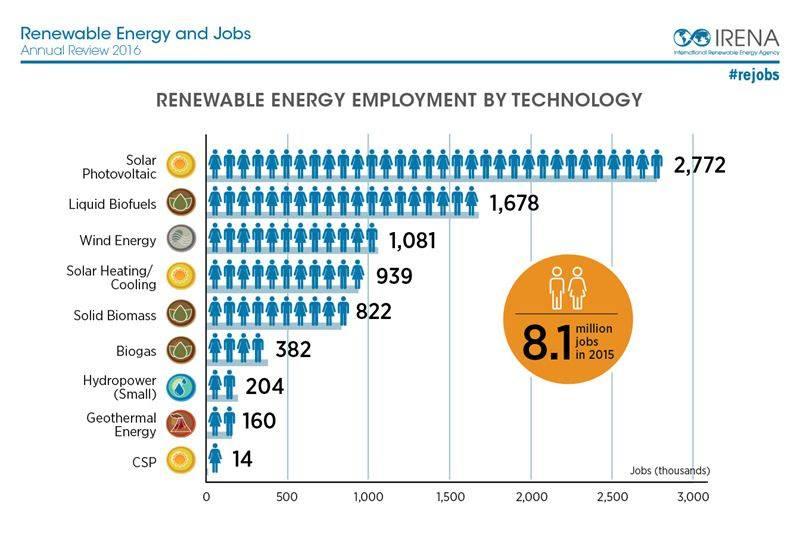

Despite low oil prices, the clean-energy sector keeps on growing, and it now employs 8.1 million people worldwide. According to the Abu Dhabi-based International Renewable Energy Agency (IRENA), this is an approximate 5 percent increase from last 2014. While that may not seem like a huge boost, just about any sector would boast about such a rate of growth.
For advocates of the “green jobs” movement, these numbers are encouraging even as some countries curtail their clean-energy programs. In the Middle East, for example, Saudi Arabia is lowering the bar for its ambitious solar expansion: Bloomberg reported on Wednesday that the nation will plan to install 9.5 gigawatts of solar power -- a mere quarter of the capacity its leaders targeted four years ago. The government of Japan, which has struggled to electrify the country since the 2011 Fukushima disaster, is pushing forward with plans to build as many as 47 coal-fired power plants. And the United Kingdom, where one clean-energy trade group claims job growth in renewables far outpaces other sectors, has seen the development in renewables decline as investors view the current Tory government as hostile to clean energy.
But in much of the world, renewables are on the upswing, creating a job market that has become more robust while the conventional energy sector sheds workers. In the United States, approximately 769,000 people work within the renewable energy industry. IRENA’s data suggest that overall U.S. job growth in this industry rose 6 percent in 2015, with employment in the solar power sector soaring by almost 22 percent to reach 209,000 jobs. Additional installations within the wind power sector led to similar increases: Wind employment rose by 21 percent to 88,000 workers.
Renewables continue to offer job opportunities even in countries with sputtering economies. In Brazil, for example, 918,000 people work in the clean-energy sector, with employment increasing in the wind and biodiesel industries. Halfway across the world, China, which has over 3.5 million working in the renewables sector, saw a slight decrease in employment last year, which IRENA attributes to increased automation and consolidation with the country’s solar industry. India, South Africa and Northern African countries also saw steady employment gains in the renewables sector.
Future growth in renewables will depend on government policy and, of course, the price of oil -- which briefly surpassed $50 yesterday. But where job growth is really making a difference is in developing countries, where renewables have become critical for expanding energy access while providing economic opportunities. Bangladesh, for example, now has 141,000 workers within the renewables sector, and the majority of them manufacture or install solar home systems. Companies including M-KOPA, which hired 22,000 workers across East Africa, serve as examples of how firms can be profitable while contributing to the rise of social enterprise in these nations.
Clean energy still has a long road ahead. Much of its expansion depends on the transfer of skills and continued training. And while IRENA suggests approximately 35 percent of workers in the global renewables industry are female — a higher ratio when compared to the energy sector at large, which employs 20 to 25 percent women — critics are quick to point out that the clean-energy industry is still a man’s world. But as IRENA’s study suggests, renewables -- once touted as a way to address climate change -- could become important for another role: alleviating poverty in many of the world’s poorest nations.
Image credits: 1) Leon Kaye; 2) IRENA
Top Chefs Urge Congress To Take Action On Food Waste
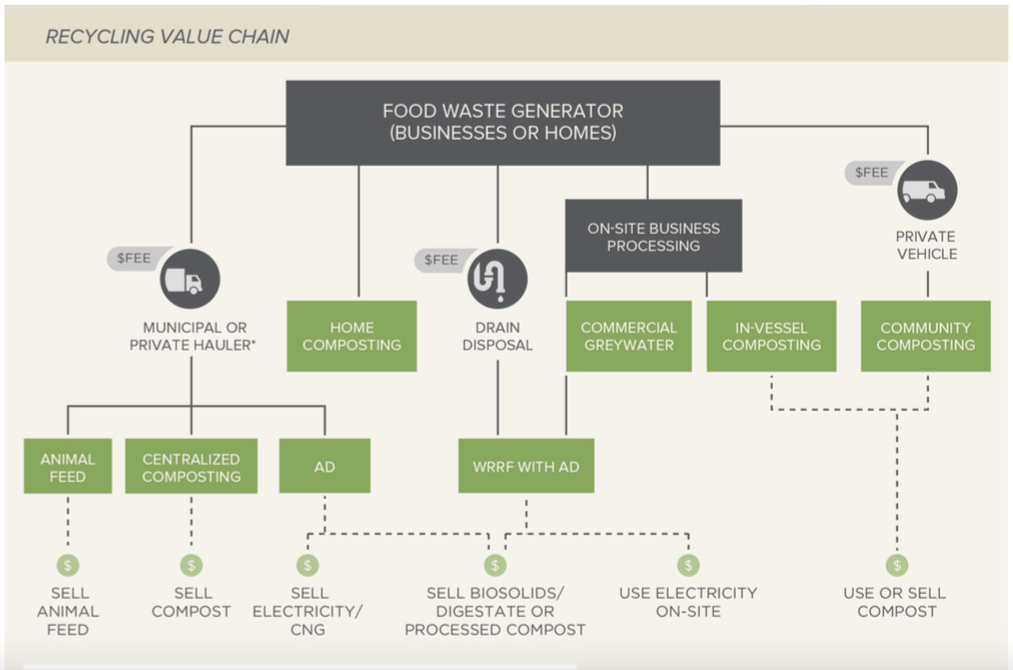

On May 25, the national food policy organization Food Policy Action Education Fund (FPA-EF) and its co-founder, celebrity chef Tom Colicchio, walked the halls of Congress with our nation’s top chefs and food waste advocates for a day of action on Capitol Hill. Their goal? Educate lawmakers about food waste reduction in the American food system.
“Food waste is a more than $200 billion problem in America. It hurts the economy, our environment and our people,” said Tom Colicchio, food advocate, FPA-EF co-founder and “Top Chef” head judge.
“As chefs, it’s in our best interest to make sure safe, edible product does not go unused. We are here to help Congress understand that it’s in our country’s best interest to do the same. I am happy that so many chefs and leading experts are here with me today to help drive positive, bipartisan change.”
The roadmap to reduce U.S. food waste
Food waste experts and advocates used data and insights from Rethink Food Waste Through Economics and Data’s (ReFED) Roadmap to Reduce U.S. Food Waste, released in March, to push for common-sense action that can be taken now to address this urgent and solvable problem.
ReFED’s Roadmap shows an achievable path to a 20 percent reduction in food waste within a decade through 27 cost-effective, feasible and scalable solutions that could generate thousands of new jobs, bolster the economy, and divert 13 million tons from landfills and on-farm losses.
The Roadmap was developed to identify the most cost-effective solutions to cut food waste at scale, to define research priorities, and to spur multi-stakeholder action. Today, the United States spends over $218 billion – 1.3 percent of GDP – on growing, processing, transporting and disposing of food that is never eaten.
Each year, 52.4 million tons of food is sent to landfills and an additional 10.1 million tons remains unharvested at farms, totaling roughly 63 million tons of annual waste. This is not only wasted food, but also wasted energy. Over 40 percent of the energy that we use to produce food goes to waste.
Not to mention the detrimental effects that wasted food has on our water supply. The water that is embedded in the food we throw out could meet the household needs of over 500 million people. Then there is the issue of the wasted land. We are essentially trashing our farm lands and pumping greenhouse gas emissions into the atmosphere at alarming rates to grow food that no one eats. We’re contributing to climate change from the comfort of our kitchen waste bins.
Meanwhile, as more than 60 million tons of food is thrown out, one in seven Americans is food insecure. ReFED envisions a future where combatting food waste is not only a core driver of business profits but also job creation, hunger relief and environmental protection. The report offers solutions in three key areas.
Prevention solutions
“An ounce of prevention is worth a pound of cure.” Whether in health care, energy or criminal justice, the most efficient way to solve a critical social problem is often to invest in prevention. The same holds true with tackling food waste, where solutions that avoid waste offer the largest social, environmental and economic benefits. Therefore, ReFED argues that prevention should be the first priority for effective management of food waste.
Prevention is applicable across the value chain, from farms to homes. The Roadmap shows that prevention creates three times the societal net economic value of recovery and recycling combined. Solutions that prevent waste in businesses and homes have the greatest Economic Value per ton and net environmental benefit, diverting 2.6 million tons of annual waste.
The top three solutions with the greatest economic value all utilize prevention: standardized date labeling, consumer education campaigns and packaging adjustments. These solutions require a relatively low investment to provide new information to consumers to shift wasteful behavior. Meanwhile, they avoid large volumes of food from being wasted, leading to high relative savings for consumers.
Recovery solutions
We’ve all seen perfectly good food thrown away at a restaurant, bakery, or dinner party and wished there was a way to get it to people in need. Food recovery captures that food and transports it while it is still edible to help address the issue of food insecurity.
Although food recovery initiatives already exist throughout the country, there is a significant opportunity to increase donations. Food recovery networks in the U.S. spanning food banks, pantries, soup kitchens, shelters and other agencies, already receive and distribute nearly 1.7 million tons of rescued food each year.
Based on ReFED’s analysis, over three times this amount, up to 5.8 million additional tons, could be feasibly recovered from food businesses in one day. The Roadmap shows how approximately 20 percent of this additional recovery potential, or 1.1 million tons (1.8 billion meals), can cost-effectively be recovered over the next decade.
Recycling solutions
After pursuing as much prevention and recovery as possible, food scraps still inevitably remain. Today, the vast majority of wasted food ends up in landfills where it costs cities millions of dollars per year in disposal fees and rapidly releases methane, a potent greenhouse gas. Yet food scraps are actually a resource that can be harvested to create a closed-loop system that supports a vibrant agricultural sector, energy independence, and greener cities.
Centralized composting and anaerobic digestion (AD), as well as a smaller set of growing distributed solutions, will enable 9.5 million tons of waste diversion, nearly 75 percent of the total potential. Centralized composting diverts the most waste, adding over 2 million tons of compost annually to fuel growth in the sustainable farming and environmental remediation markets.
“We need Congress to be part of the solution,” Colicchio said. “We applaud the House Agriculture Committee for leading the charge and working across the aisle to reduce food waste, which will reduce hunger, bolster the economy and help farmers. Reducing food waste today can make a huge positive difference for our food system tomorrow.”
Image credits: 1) and 2) Larry French/Getty Images for Food Policy Action Education Fund (used with permission); 3) 4) and 5) ReFED Roadmap to Reduce U.S. Food Waste
Obama Touts Hip-Hop in Suppressed Vietnam

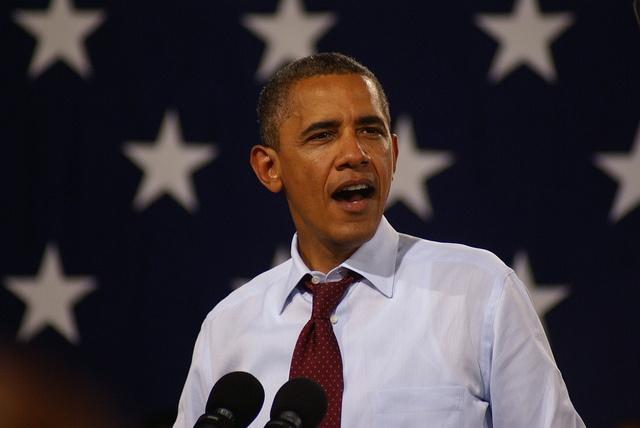
While fielding questions from members of the Young Southeast Asian Leadership Initiative in Ho Chi Minh City, Vietnam, President Barack Obama was given the perfect cue to discuss human expression in the communist country when Suboi stepped up to the mic.
The female rapper asked the president how important arts and culture — hip-hop in this well-known Vietnamese artist’s case — is to promoting a strong future for a nation. But before answering the question, Obama challenged Suboi to perform a verse: “Let’s see what you got. Come on!”
After Obama offered to beatbox for the young artist, he watched as she rapped in Vietnamese. Obama admitted he couldn't understand Suboi’s native tongue, and she explained that she was “just talking about some people having a lot of money, having big houses; but actually, are they really happy?”
Arts and culture is routinely suppressed by the Vietnamese government, and the country also enacted restrictions enacted that limit Internet-users ability to criticize the government. Decree 174, effective since the beginning of 2014, threatens fines just shy of $5,000 for government critiques on social media.
Freedom House, a watchdog organization “dedicated to the expansion of freedom and democracy around the world,” ranked Vietnam the third worst country in the Asia-Pacific region in its Freedom of the Press 2016 report. China marginally edged out Vietnam as being more suppressive while North Korea ran away with the title, marking an unprecedented 97 on a scale of 100 — with 100 noting the worst.
In a country where bloggers, reporters, social media users and even rappers can’t express themselves in their posts, stories, tweets and songs, Suboi wanted to know art’s influence in a country championed by democracy.
Obama admitted that he understands government’s hesitation for free and open expression but said, “If you try to suppress the arts, then I think you’re suppressing the deepest dreams and aspirations of a people.”
He mentioned that rap was conceptualized in poor neighborhoods of America and while N.W.A. may not have been featured in Ronald Reagan’s Walkman, the group wasn’t regulated — not even after its famed song “F*ck Tha Police” came out following the controversial 1992 acquittals of the four LAPD officers who beat Rodney King the year prior.
“Imagine if at the time when rap was starting off, that our government had said ‘no because some of the things you say are offensive, or some of the lyrics are rude, or you’re cursing too much,’” Obama said. “That connection that we’ve seen now in hip-hop culture around the world wouldn’t exist.”
Obama made freedom of the press and expression a priority throughout his three-day trip to Vietnam, which is the first stop in his 10th trip to Asia, which will be capped by a visit to Hiroshima.
Image credit: Flickr/Marc Nozell
5 Ways Your Personal Investments Can Help Solve Climate Change
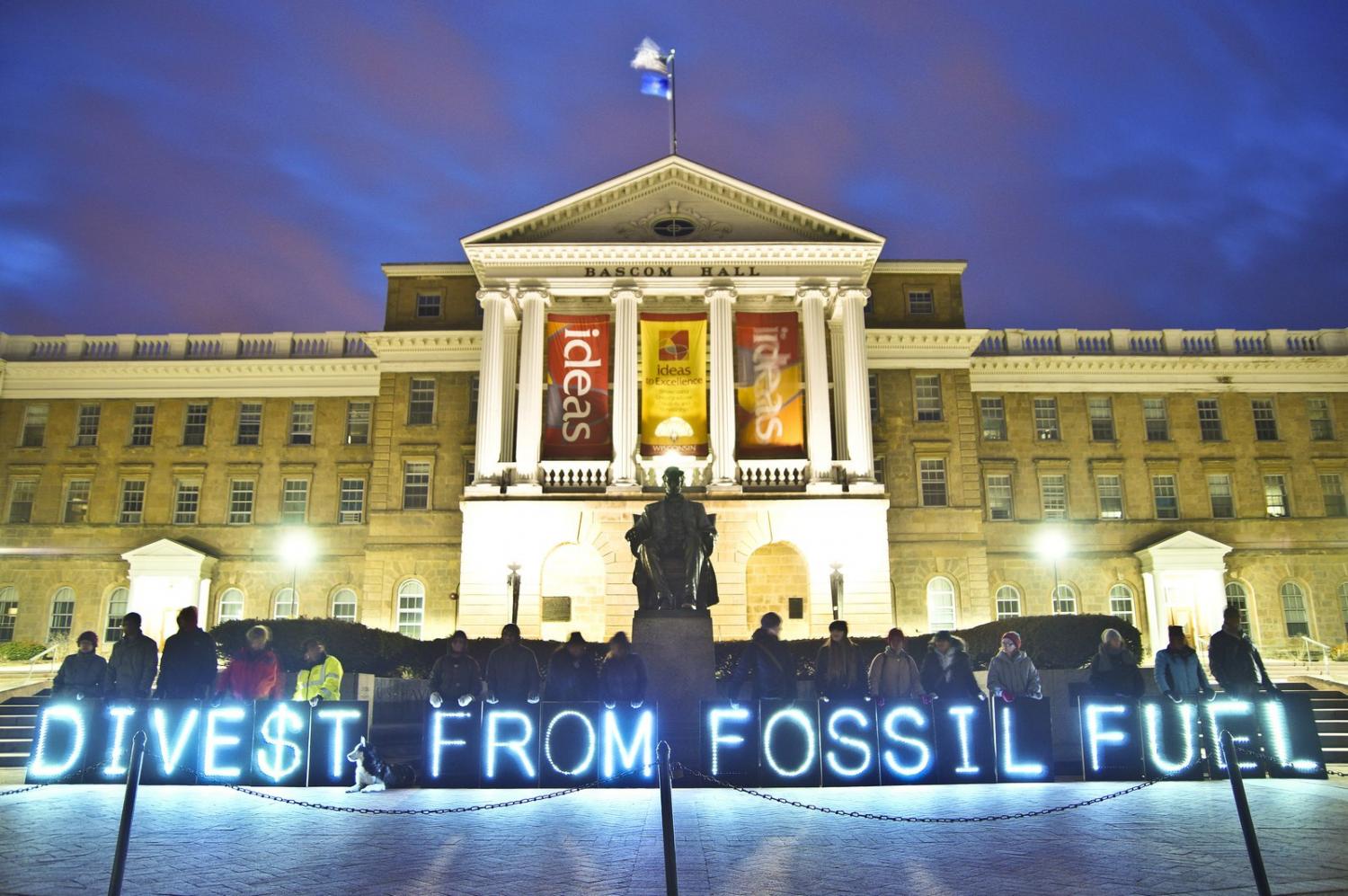

By Vanessa Green
It’s easy to feel powerless when our newsfeeds deliver story after depressing story about the accelerating impacts of climate change. It’s even easier to get angry at fossil fuel companies, which have known about and suppressed knowledge of the threat for decades, even funding climate denial and lobbying to make it harder for alternative energies to gain traction.
For investors of all sizes, there is some good news: It’s never been easier to take meaningful personal action by divesting from the companies banking on carbon reserves, and investing instead in local and scalable climate solutions.
Why divest?
By divesting, loudly and proudly, we collectively send a signal that removes the fossil fuel industries’ social license to continue business as usual. We make our voices heard and our dollars count. It’s replicable constructive action that couldn’t be more timely or prudent.
The moral imperative for divesting from fossil fuel industries is clear. Profit at the expense of a habitable planet for people alive today and for future generations is indefensible. It’s a bad business model that externalizes costs, extracts from communities and consolidates wealth beyond reason.
The financial case for divestment is equally compelling. According to the Carbon Tracker Initiative, fossil fuel companies risk wasting up to $2.2 trillion of investments in new projects that could turn out to be “uneconomic” over the next decade. In fact, if you’ve been in fossil fuels over the last few years, you have likely lost a significant amount of money – a concern for any fiduciary.
A movement takes hold
Making the decision to divest from fossil fuels may be straightforward, but actually doing it is a challenge for many people. A range of institutions have helped grow the global divestment movement -- with over $3 trillion in fossil-free assets under management, committed from icons like the Rockefeller Brothers Fund and Stanford University. But until recently, it hasn’t been clear how everyday individual investors can participate.
With more and better data, along with a growing list of helpful tools and attractive investment vehicles, the average investor and retirement fund holder can now be part of accelerating this historic movement – one based firmly in the new economy, where finance is democratized and demystified.
Sign the pledge
Recognizing this movement’s power and potential, Divest Invest is committed to helping individual and institutional investors, large and small, divest from fossil fuels and invest in better energy alternatives. It all starts with our pledge.
By signing the Individual Pledge, you are agreeing to make no new investments in the top 200 oil, gas, and coal companies that constitute The Carbon Underground 200 (CU200); to sell any current CU200 investments within 3 to 5 years; and to invest in a sustainable and equitable new energy economy.
Vote with your dollars
Once you’ve made the commitment, there are a number of ways to cast your vote:
- Take a closer look at your investment funds. If you’re invested in ETFs or mutual funds, make sure they’re the right ones. An increasing number of new funds remove CU200 companies. Some, like Etho Climate Leadership U.S. ETF (ETHO) from Etho Capital, are 100 Percent Fossil Free by going beyond the CU200 to also remove all fossil fuel extraction and services companies. There are also 100 percent Fossil Free mutual funds, including Green Century Equity Fund (GCEQX), Shelton Green Alpha Fund (NEXTX), Brown Advisory Sustainable Growth Fund (BAWAX) and Parnassus Endeavor Fund (PARWX). Many of these funds look beyond fossil fuels by only investing in efficient and sustainable companies in other industries, and some of these funds are also making more money than conventional investments.
You can find lists of fossil free funds and investment managers at 350.org and Green America, and you can learn the carbon intensity of your existing investment portfolio with CarbonScan.
- Go digital. Automated investment services are not new, but Macroclimate just introduced the first automated investment service for divestors. It’s a solid option for investors who prefer a hands-off approach, and who have at least $250,000 to invest. Macroclimate is committed to using funds that not only exceed standards of the fossil fuel divestment movement, but that have historically outperformed the market.
- Talk to your financial advisor. Tell your advisor that you want to clean up your portfolio, and be prepared with data to support your argument. You may hear that you’ll lose money by divesting from fossil fuels, but that’s not true. A number of funds, including Etho Capital, Trillium, Green Century, Parnassus and Calvert, frequently beat market benchmarks.
- Talk to your employer. Consider this: Approximately 8 to 12 percent of the over $4.4 trillion currently invested in 401(k)s is in fossil fuels. That’s $352 billion to $528 billion worth of influence in the hands of employees. If you have a 401(k), ask your HR representative about fossil free 401(k)s. Green Century's 401(k) toolkit and Fossil Free Funds and HIP Investor's 401(k) toolkit can help prepare you for this important discussion.
- Invest in sustainable solutions. The Green Century Funds webpage and Etho Capital’s Climate Efficiency page provide some descriptions of the climate solutions they invest in. These investments aren’t just excluding the bad; they also help bring the good to scale.
Our planet is calling us to action
We’re in a race against time when it comes to climate change, but new tools and technologies make taking action easier than ever before. Please, become a Divest Invest Ambassador today and invite your friends, colleagues and families to become part of the solution too.
Image credit: Flickr/Joe Brusky
Vanessa Green is Campaign Director of Divest Invest Individual.
Case Study: Green Experience Meetings at Radisson Blu Hotels Around the World


Radisson Blu® is one of the world’s leading hotel brands under the Carlson Rezidor umbrella, a hotel group that includes 1,400 hotels in 115 countries. As a global leader, Carlson Rezidor has achieved a great deal of progress when it comes to designing and operating sustainable hotels. This article will focus on the sustainable achievements made by Radisson Blu Hotels in Sweden, USA, and India. It is a huge turning point in events right now with more and more venues implementing sustainability, and Carlson Rezidor have teamed up with both Positive Impact and Triple Pundit to tell their story and inspire others across the globe with best practice examples.
Radisson Blu Waterfront Hotel Stockholm, Sweden
Radisson Blu Waterfront Hotel Stockholm was the first building in Sweden to achieve the LEED (Leadership in Energy and Environmental Design) certification; this is a green building program that recognizes “best-in-class” building strategies for a new construction. Part of this achievement is owed to the fact that 100% of the material from the previous building was used to reconstruct the hotel as it is today. A huge double glass wall acts as an energy collector which generates on average 1MW of heat energy each day, teamed with LED and long life lighting this significantly reduces the carbon footprint of the venue. The hotel also utilises its surrounding resources by using 250 tonnes of water form the lake to cool the building, a great example of how the hotel plays an active role in protecting and preserving the local environment.
In terms of Brain Food served at the events, the team designs menus from locally grown and seasonal products focusing on fair and sustainably sourced produce. A key part of their sustainability strategy when it comes to food is prioritising quality over quantity. This ensures that guests receive the best quality produce, but also reduces food waste. In the instance that there is left over food, this is compacted with the in-house balers along with any paper and plastic in order to reduce transport miles en-route to disposal at the same time as minimising cost.
Radisson Blu Hotels have even created their own initiative- Blu Planet- that Stockholm Waterfront participates in. For every 250 bath towels that the guests choose to reuse, the hotel gives a child safe water for life. This is enabled through a partnership with the ‘Just a Drop’ charity that runs water projects in Asia, Africa and Latin America. To date Radisson Blu hotels have provided safe drinking water for life to over 5,000 children.
It is no surprise that the hotel is eco-labelled – first with Swan and now with the Green Key Eco Label.
Radisson Blu Aqua Hotel, Chicago, USA
Like the Stockholm Waterfront, the Aqua Hotel Chicago is also LEED (Silver) certified and is also the only full-service hotel in Chicago to have achieved the commercial interior level of this certification. Additional achievements include the Green Key Eco-Label and the Trip advisor Green Leaders Platinum. These ecological features have been integrated in the building’s iconic design that was created by internationally acclaimed and environmentally conscious architect, Jeanne Gang of Gang Architects. During the build, Radisson Blu Aqua ensured that more than 92% of all construction waste was recycled and 17% of materials were sourced locally. In addition, the hotel also implements practical and measurable strategies which have resulted in a reduction of 21% in water use each year, installation of equipment that uses 25% less energy, 31% reduction in light power through use of LEDs, and 50% of energy is from renewable sources.
The hotel not only inspires guests through their achievements, but also encourages them to make sustainable choices themselves by providing discount cards for bike sharing services, discount parking when carpooling, and electrical car charging posts. Guests can also benefit from the hotel’s 80,000-square-foot green roof with native plants that will inspire guests to protect and nurture their natural surroundings both at the hotel and in their every day lives.
In terms of meetings, Radisson Blu Chicago serves meeting delegates Brain Food which includes a maximum of organic, local and vegetarian options, and are good for constant concentration levels of meeting delegates, and for the planet. The restaurant also minimizes plastic bottle waste by serving in-house filtered water eliminating transport miles.
Radisson Blu Hotel Nagpur, India
Radisson Blu Nagpur is located at the most central point of India and is the only LEED (Gold) Certified building in Nagpur city. The hotel developed a sustainability strategy that not only encompasses the design of the building and selection of site, but also includes a number of initiatives that have helped Radisson Blu Nagpur achieve the EarthCheck eco-label.
The hotel is a leader when it comes to renewable energy by utilising 100% energy from wind power, however, Radisson Blu Nagpur also recognises the need to reduce energy demand by installing energy saving technology such as LED lights which save on average 54,662 kWH/year. Addionally, the hotel has installed dimmers, motion sensors and occupancy sensors on guest floors to ensure energy isn’t wasted.
In addition to using wind power, the hotel boasts solar panels to heat their water supply, and is mindful of optimising the usage of water resources. This comes into action when for example when developing and maintaining the green space surrounding the premises. Radisson Blu Nagpur understands the importance of giving back to the environment and recently conducted a tree plantation project on the hotel grounds.
The hotel also has a strong social sustainability strategy employing differently abled staff to ensure local people have equal opportunities. All year-round, the Radisson Blu Nagpur coordinates a host of charitable work including clothes donations, blood donations and supporting local orphanages, woman’s rights groups, handicap organisations and elderly groups.
The future for Radisson Blu and Carlson Rezidor
Both Radisson Blu and Carson Rezidor are demonstrating sustainable practices everyday. As you can see from the case studies above, so much progress has been made at just 3 hotels. To top off all their hard work, Positive Impact has now awarded Radisson Blu Hotel Stockholm Waterfront Hotel, Radisson Blu Aqua, and Radisson Blu Nagpur with the Sustainability Supporter Recognition Stamp to acknowledge the success of their sustainable strategies. As events venues, the initiatives they implement and sustainable options they provide can make a huge difference to the industry on the whole and change the behaviours and views of event professionals world wide.
Memorial Day … Every Day


By Chris Crace, PwC
We have celebrated Memorial Day in our country for 158 years — a long, proud tradition founded for the purpose of offering “testimonials of respect to,” and “cherishing the memory of,” those who have sacrificed their lives while serving in the country’s armed forces. While it may be an especially meaningful day for those of us who have personally lost family, friends or colleagues, all Americans -- regardless of our ethnicity, religion or political beliefs -- unite on this day in remembrance of our military heroes. The idea of coming together is what interests me most this Memorial Day.
Recently our firm’s Chairman, Bob Moritz, said he believes the most significant way to memorialize the men and women who have made the ultimate of sacrifices is to honor veterans not only on one or two special days, but every day. At PwC, this means advancing initiatives across our company to hire and support veterans and their families and joining with businesses, organizations, and communities throughout the U.S. to expand employment and career opportunities for veterans and military spouses.
As our firm’s Veterans Advocacy Leader, one of the most rewarding parts of my job is connecting with the extraordinary people whose lives have been impacted by our veterans programs. This Memorial Day, I want to share a few of their stories.
Boot camp was the best decision
After serving as a platoon leader during a peacekeeping mission in the Sinai Peninsula and a Ranger Training and Assessment Course platoon trainer at the Warrior Training Center at Fort Benning, Captain Brendan McKeague decided to brave a different kind of challenge.
This year, he completed PwC’s Cybersecurity Boot Camp, an initiative to train former military personnel to design and operate the technology and processes global companies will need to mitigate the increasing risks of cyber threats. Brendan has always exhibited enormous determination and focus. He’s a two-time Gold Medalist with the All-Army Men’s Soccer Team, will graduate next year from George Mason University with a Master’s degree in Information Security and Assurance, and is working full-time with our firm as he completes his graduate degree.
“I studied liberal arts and didn’t have any formal education in information technology or computers, but my military service helped me develop the tenacity and ability to perform under pressure and do whatever it takes to pursue my goals. Joining PwC and taking part in the boot camp was the best decision I ever made,” Brendan says.
The right moves
Military personnel are not the only ones on the move. Their families must relocate, too, and it’s not an easy adjustment for anyone.
Erika Sartain, PwC's Public Sector Manager, had to give up the job she loved in New York City when her husband, Captain Joel Sartain, received orders to Marine Corps Base Camp Lejeune in North Carolina. Erika initially assumed she’d have to leave the company, but members of PwC’s Veterans Affinity Network (VAN) assured her that she would have the support to transfer offices and advance her career. They were right.
Through PwC’s VAN colleagues’ guidance, and the support of her NYC team, she found the perfect position in Raleigh and was able to work remotely as needed from Camp Lejeune. The Sartains have now moved to Washington, D.C., where Erika balances time between PwC’s offices, client offices and working remotely from home. Juggling care of their young son and her job is a challenge, but Erika has made of success of it.
“With an active duty husband, flexibility is especially important,” she says. “I know that wherever the Marine Corps sends us in the future, PwC will try to meet me there.” Erika says she has enormous pride in the firm and we are proud of her resilience and grateful for her contribution to the firm.
Remote success
Alicia Bowman, PwC Learning & Development Manager in the Greater San Diego Area, and “proud Marine wife,” is passionate about helping co-workers “grow their own way.” She is an ideal role model. Along with her husband Matthew Bowman, a Captain in the United States Marine Corps, Alicia has moved four times over the last 10 years from locations in Texas to Washington, D.C. to Southern California -- continuously evolving her role in the firm along the way. The ability to work remotely 100 percent of the time has allowed her to cope with the challenges of life while her husband was deployed in Afghanistan, and as a new mother preparing for his upcoming deployment on a naval ship next year. It hasn’t been easy.
“Long distance relationships are tough and you’re always worried about your partner’s safety,” she says. “But, I’m confident that my team will support me through whatever we must go through as a military family.” We are confident that Alicia will continue to positively shape the future of our firm’s workforce from anywhere her family must travel.
I believe the most meaningful way to celebrate Memorial Day is to support others like Brendan, Erika and Alicia and their families every day of the year. So let’s enjoy the day off to spend time with our families and participate in the various celebrations — parades and picnics — and then let’s join together to spend the rest of the year working to ensure that veterans and their spouses have support and opportunities that honor their service and sacrifices, and that enable them to reach their full potential to positively impact our companies and communities across the U.S. and abroad.
Image credit: Andrew Pons/Unsplash
A former Marine Captain, Chris Crace now serves as Veterans Advocacy Leader for PwC.
Nike Closes the Loop with Shoes Made From Trash
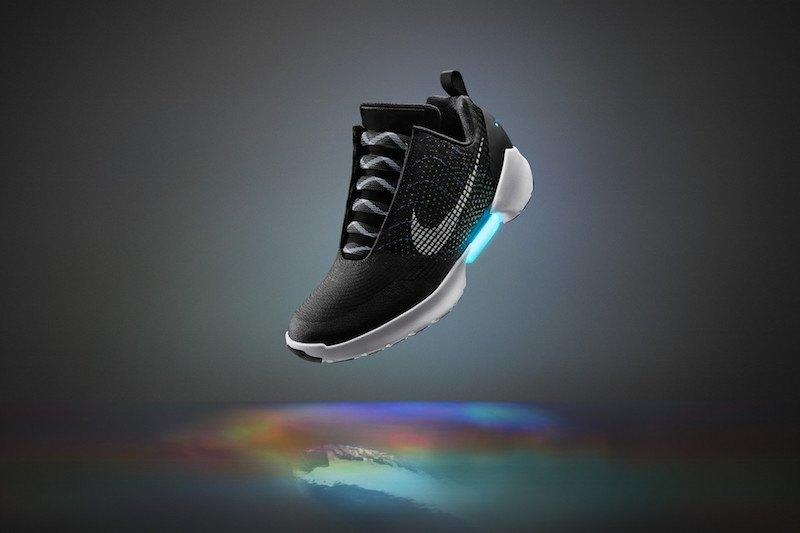

It’s highly likely that your most recent pair of Nike shoes had a previous life. Earlier this month, the athletic apparel giant announced that a whopping 71 percent of its footwear is made with materials recycled from its own manufacturing process. In 2015, the brand recovered 92 percent of its trash.
In addition to doubling down on waste diversion, Nike’s sustainability report reveals a continued and concerted effort to achieve zero-waste in its supply chain, invest in technologies to drive 100 percent renewable energy within its factories, and reduce toxic chemical output from dying processes from entering the environment.
“By creating low-impact and regenerative materials, we can continue to move toward a high-performance, closed-loop model that uses reclaimed materials from the start,” Mark Parker, Nike's president and CEO, wrote in an opening letter to the report. “Coupled with smarter designs, we can create products that maximize performance, lighten our environmental impact and can be disassembled and easily reused.”
Recycled materials are derived from old shoes, plastic bottles and factory scraps branded Nike Grind. Through a “slice-and-grind” technique, shoes are split into three sections -- separating the rubber from the outsole, foam from the midsole and fiber from the upper sole -- before they are put through a grinder and transformed into fabric pellets for future use in another pair of shoes, a track court, a playground or another athletic padding surface.
Parker goes on to share Nike’s vision of accomplishing their goals by the fiscal year 2020, achieved in part by completely eliminating footwear manufacturing waste from landfills or incineration.
Nike’s efforts are strengthened through its partnerships with NASA, the U.S. Agency for International Development and the U.S. Department of State who, since 2013, have teamed up through the Launch program to identify leaders and thinkers to “transform the system of fabrics to one that advances equitable global economic growth, drives human prosperity and replenishes the planet’s resources.”
A focus on up-front product design processes appears to drive Nike’s approach to improved product sustainability and materials sourcing. Nearly 81 percent of all of Nike’s products across every category will be reviewed for sustainability scalability by 2020. The significance of implementing sustainability measurements and metrics across the total brand will push teams to choose better materials based on an internal sustainability index, improve efficiency patterns and ultimately decrease the number of materials used to create a single product.
For example, the report states that more than 16,000 materials make it into Nike products each year with up to 30 materials used for a single pair of shoes. Using Nike’s materials index, teams can compare the environmental impacts of numerous materials based on several hundred suppliers to smartly make changes to meet brand sustainability goals.
In addition to ushering in a vision for driving their part in capping climate change while establishing accountability as long-time players in the fashion industry, Nike recently joined the Ellen MacArthur Foundation as a Global Partner. In this role, Nike will work strategically to drive scale within the circular innovation economy by working together to identify opportunities to achieve positive impact.
Value creation is amid the levers the company seeks to create as detailed within the report.
“We envision a transition from linear to circular business models and a world that demands closed-loop products – designed with better materials, made with fewer resources and assembled to allow easy reuse in new products.[...] We are re-imagining waste streams as value streams, and already our designers have access to a palette of more than 29 high-performance materials made from our manufacturing waste.”
Skipping Breakfast May Not Be the End of the World After All


You have probably heard this mantra since you were a small child: Do not skip breakfast! It's the most important meal of the day!
Anyone who is old enough to remember the “Schoolhouse Rock” cartoon series probably remembers the “Quickfast” public service announcement exhorting kids to have anything, just anything, for breakfast -- even if it was just a glass milk or a slice of cheese.
Hence, among the biggest pushers of having that breakfast to start the day are the cereal companies, and they do not just want you to have a glass of milk:
- “Ready-to-eat cereal ranks as one of the best choices available as part of a nutritious breakfast.” – Kellogg
- Breakfast eaters tend to “Have better intake of nutrients . . . [and] have healthier body weights.” – General Mills
- “Quaker Oats, a subsidiary of PepsiCo, Inc., is delivering new breakfast innovations that can help warm up consumers looking for exciting, new and tasty ways to enjoy oatmeal.”
But it is not just the food companies pushing you to have breakfast, even if you are one of those folks who tends to skip that morning meal or wait for coffee and a bagel at the office. Even revered health organizations such as the Mayo Clinic insist that breakfast is integral to starting a productive day. The Cleveland Clinic also made the timeless argument that skipping breakfast is akin to driving a car on an empty tank of gas.
But as pediatrics professor and New York Times contributor Aaron Carroll suggested in a column on Monday, the daily breakfast is not a panacea for everyone. Sure, some reports suggest that free school breakfast programs here in the U.S. have some impact. But others found little evidence that such programs make a difference in health, behavior or academics. In fact, the federal school breakfast initiative is arguably more impactful when it comes to fighting hunger, rather than boosting performance in America’s classrooms.
As for adults, breakfast has tenuous links to public health. It is easy to find studies saying that a regular breakfast can counter obesity, but as Carroll wrote, many of these studies used dubious methodology or randomized controlled trials. Then we have the food company studies. Kellogg supported a study that linked a regular breakfast with a healthy body mass index (BMI); and research funded by PepsiCo’s Quaker Oats suggested that the consumption of oatmeal and frosted cornflakes could reduce weight and cholesterol — of course, if one such breakfast in taken in a highly controlled setting for four weeks straight.
Other studies, however, found no correlation between skipping breakfast and weight gain. It may be more important where meals are eaten (as in restaurants versus home) or how many calories are consumed on a daily basis. Another study by the New England Journal of Medicine, written in part by a researcher who disclosed he had accepted fees from companies including Kraft Foods and McDonald's, found no relationship between eating breakfast and the prevention of obesity. Such findings fly in the face of research done by companies such as General Mills, which caught plenty of flak 10 years ago when it touted a study — authored by three General Mills’ employees -- to argue that sugary cereals are beneficial for children’s health.
As with any research that links food to health, there is no hard and fast rule. Knowing your body and what works for you when it comes to food, exercise and health is the first rule of thumb. But when it comes to all of these studies, it's important to ask questions: Who exactly is funding, writing and promoting this research? You have to be your own advocate when it comes to health. Do not let any company, or NGO for that matter, have an impact on how you define a healthy lifestyle — and that applies to breakfast.
Image credit: Chris Metcalf/Flickr